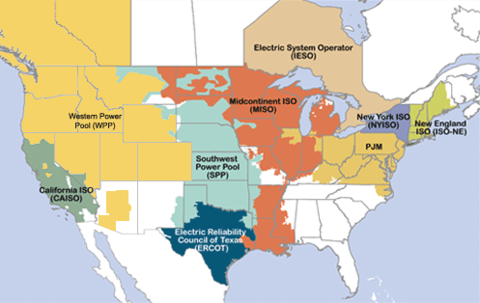CUB Sues the Bonneville Power Administration
Posted on July 22, 2025 by Charlotte Shuff
Tags, Energy, General Interest

Oregon is facing overlapping energy challenges: rising utility bills, rising electricity demand from data centers, and stalling progress on meeting clean energy requirements. The last thing we need is for one of our region’s largest clean energy suppliers to reduce ties with the Pacific Northwest. But that’s exactly what Bonneville Power Administration (BPA) is set to do.
This summer, CUB joined four other advocates across the region, represented by EarthJustice, in a lawsuit to try to reverse BPA’s decision to splinter Western energy markets, costing utility customers billions of dollars.
In this blog, we will break down many of the issues at play in energy markets and why CUB is worried about the trajectory BPA is taking.
What is Bonneville Power Administration (BPA)?
The Bonneville Power Administration (BPA) is a federal agency that operates in the Pacific Northwest. BPA controls and sells electricity generated from 31 hydroelectric dams in the Pacific Northwest.
The federal government set up BPA to both sell hydroelectric power and to run the transmission that carries power across long distances. BPA controls some 70 percent of the Northwest transmission grid, making it integral to how we all receive electric utility services. Transmitting power goes beyond just hydroelectric power, too. Our utilities contract with BPA to deliver electricity to our homes and businesses from other sources, like wind and solar farms or natural gas power plants run by utility companies.
BPA is a huge player in our region’s energy grid. This agency supplies power and/or transmission service to nearly every utility in the Northwest. BPA supplies power to our consumer-owned utilities, like city-owned utilities and co-op utilities. For-profit utilities also contract with BPA, especially for transmitting power.
An Intro to Energy Markets
In May 2025, Bonneville Power Administration (BPA) decided to make a big change in how it interacts with wholesale energy markets—how energy is bought, sold, and traded to utility companies. For a long time, the agency has been a part of energy markets that exclusively operate in the western U.S. With this big change, BPA has decided to leave the Western energy market and connect with a different market operator that primarily serves the Midwest and the South.
What is an Energy Market?
Utilities rely on much more than just the power they can produce themselves. By having a combination of many different resources, they can provide better, more reliable, and often more affordable energy services.
Utilities, federal agencies like BPA, and other power producers need a place to sell or trade energy. That’s an energy market!
“Every day, electric utilities work to reliably provide electricity to consumers. Because there is currently limited capacity to store electricity on the system, utilities must typically meet consumer demand in real time—perfectly balancing the supply of electricity with demand every minute of every day. Electric utilities can supply electricity by generating their own or by purchasing it from other generators. When utilities purchase electricity, they can either enter into bilateral transactions with other utilities or individual electricity generators, or purchase electricity from an organized market.”
- Oregon Department of Energy
There are many different types of energy markets. Here are a few examples:
- Year-Ahead Markets: Utility companies can sign contracts for electricity for the year to come based on what they expect customers will need, based on trends. This is similar to buying in bulk and having a well-stocked pantry.
- Day-Ahead Markets: Utility companies can purchase energy for the next day, based on projected demand from customers. This is particularly helpful for big fluctuations in energy usage based on the weather. This is similar to going to a grocery store for dinner tomorrow.
- Real Time Markets: Utility companies can purchase or trade energy within an hour or as soon as five minutes ahead of when they need it. This is similar to buying groceries right before a meal. Trading can also be an exchange where no money is handed off, but rather, there is an accounting of trades between utilities that is tracked over time. This is like asking your neighbor for a cup of sugar, knowing you will give them another ingredient on a different day.
Western Energy Markets
There are two main energy markets that are important to Oregon: the Western Energy Imbalance Market and the Extended Day Ahead Market.
Western Energy Imbalance Market
The Western Energy Imbalance Market is a real-time market run out of California that stretches across the West, from British Columbia to New Mexico. This market allows participating utilities to balance supply and demand within an hour. The wide footprint helps all utilities manage the needs of their customers and lower costs for everyone. When utilities opt in, they allow a grid operator to pull energy from their system and redistribute it to other utilities within minutes. Oregon customers have saved hundreds of millions of dollars from our utilities participating in this market.
This market is similar to if everyone living on the same street pooled their groceries and hired a private chef to cook meals. Each household brings enough food to cover their needs, but by pooling resources, not everyone has to bring all of the components of a single dish. The private chef assesses what everyone is bringing and makes meals that fit the dietary restrictions of each family.
In the same way, utilities bring different energy mixes to the grid operator. The grid operator redistributes power to the different states based on their clean energy requirements, customer demand in that hour, and finds the lowest cost for everyone.
BPA has long been a participant in the Western Energy Imbalance Market and is a very important player for the utilities involved. Because the agency owns the majority of the transmission in the Northwest and controls much of the hydroelectric power, its participation brings a lot of benefits to the utilities and utility customers in our region.
Extended Day Head Market
The same organization in California that runs the Western Energy Imbalance Market is currently setting up a new, day-ahead market. Portland General Electric and Pacific Power have both signed on to be a part of this market. Right now, there is no day-ahead market in the West, which is the only region in the country without one.
Having a larger regional market for buying and selling power a day ahead has a lot of benefits for utilities and utility customers. Similar to a real-time market, having a large footprint allows for a better mix of energy, more options for utilities to choose from, and lower costs for everyone.
But Bonneville Power Administration has decided not to join this market, creating a splinter in how energy is bought and sold in the West. Instead, BPA is taking the hydroelectric power generated in the Northwest and selling it into Southern and Midwestern markets. And this is going to cost Oregon utility customers a lot of money.
Splitting the Western Energy Market is Bad for Utility Customers
In CUB’s opinion, BPA’s decision not to join this new market is a bad one. BPA’s own analysis shows that joining the Western regional energy market would reduce costs by nearly $60 million for publicly-owned (or consumer-owned) utilities.
BPA’s decision to leave Western markets will have lasting effects across the Pacific Northwest.
Instead of joining the Western day-ahead market or not joining any day-ahead market at all, BPA decided to join a different market across the country. Its own analysis shows will increase costs by $108 million for municipal utilities. For all utilities, including PGE and Pacific Power, BPA leaving the western markets would add $400 million a year in overall system costs.
And utilities will pass these added costs onto customers. Utility customers, including Oregon families, will see higher costs as a result of this decision.
Bonneville Power Administration Moving to the Midwest Makes No Sense
BPA has decided to join the Southwest Power Pool’s Market+ instead of the Western Power Pool. Just looking at a map, this decision is confusing. The majority of the power BPA markets is generated in the Pacific Northwest. While the agency will still sell in the West, participating in a new market ultimately overseen (or governed) by utilities and power producers in the Midwest causes other issues. This new governance is likely to be less transparent and responsive to the needs of Oregonians.

Regional Energy Market Map
This decision is going to cost a lot of money. A separate analysis commissioned by NW Energy Coalition and others, and performed by The Brattle Group, estimated that the net system cost in the Pacific Northwest would decrease by $430 million if BPA joins Extended Day Head Market and increase by $83 million by joining Markets+.
Markets+ governance is likely to be less responsive to Northwest issues and needs. Southwest Power Pool owns Markets+, and has a board of directors that is selected by the full membership, primarily utilities and power producers located in the midwestern states. As clean energy continues to be politicized, this could cause major issues for Oregon down the line.
Bigger Grid, Better Utilities
CUB’s partner, NW Energy Coalition, breaks down the importance of having a large and diverse regional market:
All utilities in the West are considering which of two potential day-ahead trading market options to join. It is common sense that a larger, more diverse marketplace leads to lower costs and more opportunities.
Of those that have decided, the midwestern Markets+ represents a smaller set of participants that are split into separate territories. This reduces opportunities to add appropriately sited clean energy and balance energy demands using geographic diversity and a broad customer base.
The Extended Day-Ahead Market (EDAM) is the opposite: a large, interconnected market footprint. An interconnected western grid with an organized trading market is the best way to continue our progress towards a reliable and affordable fossil-fuel-free grid for the Northwest.
BPA’s choice splits the West into two day-ahead markets, creating unnecessary seams. Market seams are trading barriers where buyers and sellers cannot rely on the common rules available within the market footprint.
Oregon Needs More Clean Energy, Not Less
BPA’s choice upsets the West’s electricity markets, creating unnecessary costs and barriers for our utilities to access reliable, clean electricity.
Having more options for clean energy is necessary as Oregon moves toward 100% clean electricity. With this decision, BPA is reducing the availability of emissions-free electricity and raising the cost of power for the Pacific Northwest.
We have a better option. BPA ignored it. And we will pay the price—literally—if this decision is not reversed.
Stay Up to Date on Oregon Utility Issues
CUB will continue to advocate for people in Oregon on major utility issues. Sign up for the CUB email list for the latest updates, action alerts, and news on policies that affect the utilities your home relies on.
To keep up with CUB, like us on Facebook and follow us on Twitter!




10/24/25 | 0 Comments | CUB Sues the Bonneville Power Administration